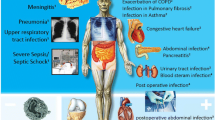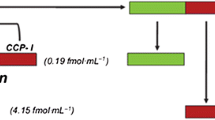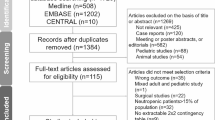Abstract
Purpose of review
The target of this review is to highlight the current evidence about the utility of procalcitonin (PCT) in different clinical conditions, such as sepsis, respiratory tract infections, urinary tract infections, and bacteremias. The authors aim to discuss the potential benefits and limitations of this biomarker and propose how to safely individualize antibiotic treatment in clinical practice.
Recent findings
Many studies have demonstrated that PCT measurements increase within 6–12 h after bacterial invasion and correlate with disease severity and outcomes of patients with infection. Consequently, they can detect the presence and monitor the status of the bacterial infection, as an objectively and quickly available marker.
Summary
PCT-guided algorithms have positive effects in reducing antimicrobial use and mortality, especially in sepsis and respiratory tract infections. However, the adherence to PCT-guided strategies is variable and more studies are needed to validate its regular clinical use on other frequent sites of infections (e.g., skin/soft tissues, bone, CNS) and on specific populations such as immunocompromised patients, since it can be truly recognized as a tool able to reduce antibiotic exposure and costs, improving quality of medical assistance safely.

Similar content being viewed by others
References and Recommended Reading
Papers of particular interest, published recently, have been highlighted as: • Of importance •• Of major importance
Kumar A, Roberts D, Wood KE, Light B, Parrillo JE, Sharma S, et al. Duration of hypotension before initiation of effective antimicrobial therapy is the critical determinant of survival in human septic shock. Crit Care Med. 2006;34(6):1589–96.
Kumar A, Ellis P, Arabi Y, Roberts D, Light B, Parrillo JE, et al. Initiation of inappropriate antimicrobial therapy results in a fivefold reduction of survival in human septic shock. Chest. 2009;136(5):1237–48. https://doi.org/10.1378/chest.09-0087.
Spurling GKP, Del Mar CB, Dooley L, Foxlee R, Farley R. Delayed antibiotics for respiratory infections. Cochrane Database Syst Rev. 2017;9:CD004417. https://doi.org/10.1002/14651858.
Rhodes A, Evans LE, Alhazzani W, Levy MM, Antonelli M, Ferrer R, et al. Surviving Sepsis Campaign: international guidelines for management of sepsis and septic shock: 2016. Intensive Care Med. 2017;43(3):304–77. https://doi.org/10.1007/s00134-017-4683-6.
Klein Klouwenberg PM, Cremer OL, van Vught LA, Ong DS, Frencken JF, Schultz MJ, et al. Likelihood of infection in patients with presumed sepsis at the time of intensive care unit admission: a cohort study. Crit Care. 2015;19:319. https://doi.org/10.1186/s13054-015-1035-1.
Gonzales R, Steiner JF, Sande MA. Antibiotic prescribing for adults with colds, upper respiratory tract infections, and bronchitis by ambulatory care physicians. JAMA. 1997;278(11):901–4.
Goossens H, Ferech M, Vander Stichele R, Elseviers M. Outpatient antibiotic use in Europe and association with resistance: a cross-national database study. Lancet. 2005;365(9435):579–87.
Lawrence KL, Kollef MH. Antimicrobial stewardship in the intensive care unit: advances and obstacles. Am J Respir Crit Care Med. 2009;179(6):434–8. https://doi.org/10.1164/rccm.200809-1394CP.
Hranjec T, Rosenberger LH, Swenson B, Metzger R, Flohr TR, Politano AD, et al. Aggressive versus conservative initiation of antimicrobial treatment in critically ill surgical patients with suspected intensive-care-unit-acquired infection: a quasi-experimental, before and after observational cohort study. Lancet Infect Dis. 2012;12(10):774–80. https://doi.org/10.1016/S1473-3099(12)70151-2.
Whitney CG, Farley MM, Hadler J, Harrison LH, Lexau C, Reingold A, et al. Increasing prevalence of multidrug-resistant Streptococcus pneumoniae in the United States. N Engl J Med. 2000;343(26):1917–24.
Kaukonen KM, Bailey M, Pilcher D, Cooper DJ, Bellomo R. Systemic inflammatory response syndrome criteria in defining severe sepsis. N Engl J Med. 2015;372(17):1629–38. https://doi.org/10.1056/NEJMoa1415236.
Jun KR, Lee JN, Song SA, Oh SH, Lee JY, Shin JH, et al. Serial changes in serum procalcitonin, interleukin 6, and C-reactive protein levels according to non-specific surgical stimulation. Clin Chem Lab Med. 2015;53(4):549–58. https://doi.org/10.1515/cclm-2014-0090.
Henriquez-Camacho C, Losa J. Biomarkers for sepsis. Biomed Res Int. 2014;2014:547818–6. https://doi.org/10.1155/2014/547818.
Schuetz P, Litke A, Albrich WC, Mueller B. Blood biomarkers for personalized treatment and patient management decisions in community-acquired pneumonia. Curr Opin Infect Dis. 2013;26(2):159–67. https://doi.org/10.1097/QCO.0b013e32835d0bec.
Puskarich MA, Trzeciak S, Shapiro NI, Albers AB, Heffner AC, Kline JA, et al. Whole blood lactate kinetics in patients undergoing quantitative resuscitation for severe sepsis and septic shock. CHEST. 2013;143(6):1548–53. https://doi.org/10.1378/chest.12-0878.
Schuetz P, Mueller B. Procalcitonin: an effective screening tool and safe therapeutic decision making aid for emergency department patients with suspected sepsis. Ann Emerg Med. 2015;66:318–9. https://doi.org/10.1016/j.annemergmed.2015.03.029.
Schuetz P, Mueller B. Biomarker-guided de-escalation of empirical therapy is associated with lower risk for adverse outcomes. Intensive Care Med. 2014;40(1):141. https://doi.org/10.1007/s00134-013-3139-x.
Davies J. Procalcitonin. J Clin Pathol. 2015;68(9):675–9. https://doi.org/10.1136/jclinpath-2014-202807.
Muller B, Becker KL, Schachinger H, Rickenbacher PR, Huber PR, Zimmerli W, et al. Calcitonin precursors are reliable markers of sepsis in a medical intensive care unit. Crit Care Med. 2000;28(4):977–83.
Linscheid P, Seboek D, Schaer DJ, Zulewski H, Keller U, Muller B. Expression and secretion of procalcitonin and calcitonin gene-related peptide by adherent monocytes and by macrophage-activated adipocytes. Crit Care Med. 2004;32:1715–21.
Becker KL, Nylén ES, White JC, Müller B, Snider RH. Procalcitonin and the calcitonin gene family of peptides in inflammation, infection, and sepsis: a journey from calcitonin back to its precursors. J Clin Endocrinol Metab. 2004;89(4):1512–25.
Schuetz P, Mueller B, Trampuz A. Serum procalcitonin for discrimination of blood contamination from bloodstream infection due to coagulase-negative staphylococci. Infection. 2007;35(5):352–5.
Kutz A, Briel M, Christ-Crain M, Stolz D, Bouadma L, Wolff M, et al. Prognostic value of procalcitonin in respiratory tract infections across clinical settings. Crit Care. 2015;19:74. https://doi.org/10.1186/s13054-015-0792-1.
Sager R, Kutz A, Mueller B, Schuetz P. Procalcitonin guided diagnosis and antibiotic stewardship revisited. BMC Med. 2017;15(1):15. https://doi.org/10.1186/s12916-017-0795-7.
Klompas M, Calandra T, Singer M. Antibiotics for sepsis-finding the equilibrium. JAMA. 2018;320(14):1433–4. https://doi.org/10.1001/jama.2018.12179.
•• Schuetz P, Wirz Y, Sager R, Christ-Crain M, Stolz D, Tamm M, et al. Effect of procalcitonin-guided antibiotic treatment on mortality in acute respiratory infections: a patient level meta-analysis. Lancet Infect Dis. 2018;18:95–107. https://doi.org/10.1016/S1473-3099(17)30592-3 This excellent meta-analysis with 6708 patients showed that the use of procalcitonin to guide antibiotic use in patients with respiratory infections can improve survival and reduce antibiotic exposure and side effects.
Menendez R, Torres A, Zalacain R, Aspa J, Martín-Villasclaras JJ, Borderías L, et al. Guidelines for the treatment of community-acquired pneumonia. Am J Respir Crit Care Med. 2005;172(6):757–62.
Aujesky D, Fine MJ. Does guideline adherence for empiric antibiotic therapy reduce mortality in community-acquired pneumonia? Am J Respir Crit Care Med. 2005;172(6):655–6.
National Institute for Health and Care Excellence. Assessment of community acquired pneumonia. London: NICE; 2018. https://pathways.nice.org.uk/pathways/pneumonia
Kalil AC, Metersky ML, Klompas M, Muscedere J, Sweeney DA, Palmer LB, et al. Management of adults with hospital-acquired and ventilator-associated pneumonia: 2016 clinical practice guidelines by the Infectious Diseases Society of America and the American Thoracic Society. Clin Infect Dis. 2016;63(5):e61–e111. https://doi.org/10.1093/cid/ciw353.
Singer M, Deutschman CS, Seymour CW, Shankar-Hari M, Annane D, Bauer M, et al. The Third International Consensus Definitions for Sepsis and Septic Shock (Sepsis-3). JAMA. 2016;315(8):801–10. https://doi.org/10.1001/jama.2016.0287.
Wacker C, Prkno A, Brunkhorst FM, Schlattmann P. Procalcitonin as a diagnostic marker for sepsis: a systematic review and meta-analysis. Lancet Infect Dis. 2013;13:426–35. https://doi.org/10.1016/S1473-3099(12)70323-7.
Bloos F, Trips E, Nierhaus A, Briegel J, Heyland DK, Jaschinski U, et al. Effect of sodium selenite administration and procalcitonin-guided therapy on mortality in patients with severe sepsis or septic shock: a randomized clinical trial. JAMA Intern Med. 2016;176(9):1266–76. https://doi.org/10.1001/jamainternmed.2016.2514.
Bouadma L, Luyt CE, Tubach F, Cracco C, Alvarez A, Schwebel C, et al. Use of procalcitonin to reduce patients’ exposure to antibiotics in intensive care units (PRORATA trial): a multicentre randomised controlled trial. Lancet. 2010;375(9713):463–74. https://doi.org/10.1016/S0140-6736(09)61879-1.
de Jong E, van Oers JA, Beishuizen A, Vos P, Vermeijden WJ, Haas LE, et al. Efficacy and safety of procalcitonin guidance in reducing the duration of antibiotic treatment in critically ill patients: a randomized, controlled, open-label trial. Lancet Infect Dis. 2016;16(7):819–27. https://doi.org/10.1016/S1473-3099(16)00053-0.
•• Wirz Y, Meier MA, Bouadma L, Luyt CE, Wolff M, Chastre J, et al. Effect of procalcitonin-guided antibiotic treatment on clinical outcomes in intensive care unit patients with infection and sepsis patients: a patient-level meta-analysis of randomized trials. Crit Care. 2018;22(1):191–202. https://doi.org/10.1186/s13054-018-2125-7 This paper was a meta-analysis focusing on procalcitonin-guided antibiotic management in septic patients and demonstrated that its use can improve survival and decrease antibiotic treatment duration.
Knaus WA, Draper EA, Wagner DP, Zimmerman JE. APACHE II: a severity of disease classification system. Crit Care Med. 1985;13:818–29.
Moreno RP, Metnitz PG, Almeida E, Jordan B, Bauer P, Campos RA, et al. SAPS 3--from evaluation of the patient to evaluation of the intensive care unit. Part 2: development of a prognostic model for hospital mortality at ICU admission. Intensive Care Med. 2005;31(10):1345–55.
Vincent JL, Moreno R, Takala J, Willatts S, De Mendonça A, Bruining H, et al. The SOFA (Sepsis-related Organ Failure Assessment) score to describe organ dysfunction/failure. Intensive Care Med. 1996;22:707–10.
Hochreiter M, Kohler T, Schweiger AM, Keck FS, Bein B, von Spiegel T, et al. Procalcitonin to guide duration of antibiotic therapy in intensive care patients: a randomized prospective controlled trial. Crit Care. 2009;13:R83. https://doi.org/10.1186/cc7903.
Nobre V, Harbarth S, Graf JD, Rohner P, Pugin J. Use of procalcitonin to shorten antibiotic treatment duration in septic patients: a randomized trial. Am J Respir Crit Care Med. 2008;177:498–505.
Schuetz P, Briel M, Christ-Crain M, Stolz D, Bouadma L, Wolff M, et al. Procalcitonin to guide initiation and duration of antibiotic treatment in acute respiratory infections: an individual patient data meta-analysis. Clin Infect Dis. 2012;55:651–62. https://doi.org/10.1093/cid/cis464.
Karlsson S, Heikkinen M, Pettila V, Alila S, Väisänen S, Pulkki K, et al. Predictive value of procalcitonin decrease in patients with severe sepsis: a prospective observational study. Crit Care. 2010;14:R205. https://doi.org/10.1186/cc9327.
Jensen JU, Heslet L, Jensen TH, Espersen K, Steffensen P, Tvede M. Procalcitonin increase in early identi- fication of critically ill patients at high risk of mortality. Crit Care Med. 2006;34:2596–602.
Schuetz P, Maurer P, Punjabi V, Desai A, Amin DN, Gluck E. Procalcitonin decrease over 72 h in US critical care units predict fatal outcome in sepsis patients. Crit Care. 2013;17:R115. https://doi.org/10.1186/cc12787.
• Schuetz P, Birkhahn R, Sherwin R, Jones AE, Singer A, Kline JA, et al. Serial procalcitonin predicts mortality in severe sepsis patients: results from the Multicenter Procalcitonin MOnitoring SEpsis (MOSES) study. Crit Care Med. 2017;45(5):781–9. https://doi.org/10.1097/CCM.0000000000002321 This multicenter observational clinical trial conducted in 13 emergency departments and ICUs in USA showed that the procalcitonin clearance by more than 80% from baseline to day 4 is a significant independent predictor of mortality in patients with sepsis.
Musher DM, Thorner AR. Community-acquired pneumonia. N Engl J Med. 2014;371:1619–28. https://doi.org/10.1056/NEJMra1312885.
Luyt CE, Guérin V, Combes A, Trouillet JL, Ayed SB, Bernard M, et al. Procalcitonin kinetics as a prognostic marker of ventilator-associated pneumonia. Am J Respir Crit Care Med. 2005;171:48–53.
Schuetz P, Christ-Crain M, Thomann R, Falconnier C, Wolbers M, Widmer I, et al. Effect of procalcitonin-based guidelines vs standard guidelines on antibiotic use in lower respiratory tract infections: the ProHOSP randomized controlled trial. JAMA. 2009;302:1059–66. https://doi.org/10.1001/jama.2009.1297.
Christ-Crain M, Stolz D, Bingisser R, Müller C, Miedinger D, Huber PR, et al. Procalcitonin guidance of antibiotic therapy in community-acquired pneumonia: a randomized trial. Am J Respir Crit Care Med. 2006;174:84–93.
Christ-Crain M, Jaccard-Stolz D, Bingisser R, Gencay MM, Huber PR, Tamm M, et al. Effect of procalcitonin-guided treatment on antibiotic use and outcome in lower respiratory tract infections: cluster-randomised, single-blinded intervention trial. Lancet. 2004;363:600–7.
Schuetz P, Wirz Y, Sager R, Christ-Crain M, Stolz D, Tamm M, et al. Procalcitonin to initiate or discontinue antibiotics in acute respiratory tract infections. Cochrane Database Syst Rev. 2017;10:CD007498. https://doi.org/10.1002/14651858.CD007498.pub3.
US Food and Drug Administration. FDA press release. FDA clears test to help manage antibiotic treatment for lower respiratory tract infections and sepsis. 2017. https://www.fda.gov/NewsEvents/Newsroom/PressAnnouncements/ucm543160.htm.
Huang DT, Yealy DM, Filbin MR, Brown AM, Chang CH, Doi Y, et al. Procalcitonin-guided use of antibiotics for lower respiratory tract infection. N Engl J Med. 2018;379:236–49. https://doi.org/10.1056/NEJMoa1802670.
Foxman B. Urinary tract infection syndromes: occurrence, recurrence, bacteriology, risk factors, and disease burden. Infect Dis Clin N Am. 2014;28:1–13. https://doi.org/10.1016/j.idc.2013.09.003.
Hooton TM. Clinical practice. Uncomplicated urinary tract infection. N Engl J Med. 2012;366:1028–37. https://doi.org/10.1056/NEJMcp1104429.
Wagenlehner FM, Schmiemann G, Hoyme U, Funfstuck R, Hummers-Pradier E, Kaase M, et al. National S3 guideline on uncomplicated urinary tract infection: recommendations for treatment and management of uncomplicated community-acquired bacterial urinary tract infections in adult patients. Urologe A. 2011;50:153–69. https://doi.org/10.1007/s00120-011-2512-z.
Drozdov D, Schwarz S, Kutz A, Grolimund E, Rast AC, Steiner D, et al. Procalcitonin and pyuria-based algorithm reduces antibiotic use in urinary tract infections: a randomized controlled trial. BMC Med. 2015;1(13):104–17. https://doi.org/10.1186/s12916-015-0347-y.
Meier AM, Branche A, Neeser OL, Wirz Y, Haubitz S, Bouadma L, et al. Procalcitonin-guided antibiotic treatment in patients with positive blood cultures: a patient-level meta-analysis of randomized trials. Clin Infect Dis. 2018;25. https://doi.org/10.1093/cid/ciy917.
Becker KL, Snider R, Nyle ES. Procalcitonin assay in systemic inflammation, infection, and sepsis: clinical utility and limitations. Crit Care Med. 2008;36(3):941–52. https://doi.org/10.1097/CCM.0B013E318165BABB.
Schuetz P, Bolliger R, Merker M, Christ-Crain M, Stolz D, Tamm M, et al. Procalcitonin-guided antibiotic therapy algorithms for different types of acute respiratory infections based on previous trials. Expert Rev Anti-Infect Ther. 2018;16(7):555–64. https://doi.org/10.1080/14787210.2018.1496331.
Author information
Authors and Affiliations
Corresponding author
Ethics declarations
Conflict of Interest
Fabrício Torres de Carvalho declares that he has no conflict of interest. Roberto Rabello Filho declares that he has no conflict of interest. Lucas Bulgarelli declares that he has no conflict of interest. Ary Serpa Neto declares that he has no conflict of interest. Rodrigo Octavio Deliberato declares that he has no conflict of interest.
Human and Animal Rights and Informed Consent
This article does not contain any studies with human or animal subjects performed by any of the authors.
Additional information
Publisher’s Note
Springer Nature remains neutral with regard to jurisdictional claims in published maps and institutional affiliations.
This article is part of the Topical Collection on New Technologies and Advances in Infections Prevention
This work was performed in the intensive care unit of Hospital Israelita Albert Einstein.
Rights and permissions
About this article
Cite this article
de Carvalho, F.T., Rabello Filho, R., Bulgarelli, L. et al. Procalcitonin as a Diagnostic, Therapeutic, and Prognostic Tool: a Critical Review. Curr Treat Options Infect Dis 11, 1–11 (2019). https://doi.org/10.1007/s40506-019-0178-z
Published:
Issue Date:
DOI: https://doi.org/10.1007/s40506-019-0178-z




